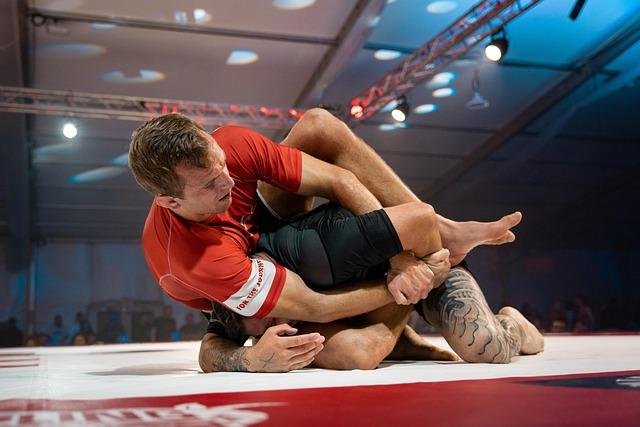In a remarkable display of skill and technique, rising UFC welterweight contender Jack Della Maddalena secured a submission victory over renowned Brazilian Jiu-Jitsu specialist Craig Jones during a recent training session. The unexpected turn in their sparring not only highlighted Della Maddalena’s evolving grappling prowess but also sent ripples thru the MMA community, underscoring the fierce competitiveness and constant growth that define the sport.
Table of Contents:
- Jack Della Maddalena Demonstrates Superior Technique in Training Session
- Analyzing the Key Moves That Led to Craig Jones Submission
- Insights into the Training Regimen Behind the Upset
- What Fighters Can Learn from Della Maddalena’s Grappling Strategy
- Wrapping Up
Jack Della Maddalena Demonstrates Superior Technique in Training Session
In a recent training session that sent ripples through the BJJ community, Jack Della Maddalena showcased an impressive display of skill and precision against renowned Brazilian Jiu-Jitsu champion Craig Jones. Throughout the drill, Maddalena’s ability to blend striking setups with submission grappling advanced his status beyond just a formidable MMA fighter—highlighting his complex mat game. Observers noted his calm demeanor and tactical patience, bargaining his timing to secure a smooth submission that left Jones no room to maneuver.
Key highlights from the session included:
- Effective chaining of takedowns into dominant ground positions
- Utilization of subtle grip control to dismantle Jones’ defenses
- Expert application of leverage-focused submissions, culminating in a precise choke
Jack’s performance not only reinforced his reputation but also set a new benchmark for technical excellence within MMA-BJJ integration. fans and practitioners alike eagerly anticipate seeing how this evolving skill set will translate into his forthcoming competitive bouts.
Analyzing the Key Moves That Led to Craig Jones Submission
In a striking display of technical prowess, Jack Della Maddalena’s approach to securing the submission was a textbook exmaple of strategic grappling execution. From the outset, he maintained relentless pressure, controlling Craig jones’ movement and systematically nullifying the BJJ champion’s offensive options. Key to this was his ability to anticipate Jones’ signature guards and transitions, allowing Maddalena to effectively cut off escape routes and set up his attacks with precision.
The decisive moment came as Maddalena capitalized on a slight positional adjustment from Jones, quickly isolating the arm and locking in a tight submission hold. Several factors contributed to the success of this move:
- Superior grip control that prevented Jones from posturing or defending effectively
- Seamless hip movement to maximize leverage and tighten the hold
- Consistent pressure that drained jones’ stamina and forced a critical mistake
This combination of tactical insight and flawless execution highlights why Maddalena’s performance resonated beyond the standard training sessions,marking a critically important milestone against a world-class brazilian Jiu-Jitsu practitioner.
Insights into the Training Regimen Behind the Upset
Jack Della Maddalena’s victory over Craig Jones was no mere stroke of luck, but rather the result of a painstakingly crafted training regimen that pushed boundaries and rewrote expectations. Emphasizing a multidisciplinary approach, Maddalena integrated rigorous Brazilian Jiu-Jitsu drills with high-intensity striking combinations, fostering a seamless blend of grappling finesse and combat readiness. His camp focused heavily on live sparring sessions designed to simulate the unpredictability and pressure of real match conditions, enhancing his adaptability and mental resilience.
Distinctive elements of his preparation included:
- Targeted positional drilling specific to Craig Jones’s signature moves
- Strength and conditioning tailored to sustain explosive power over extended bouts
- In-depth video analysis sessions to anticipate and counter Jones’s submission attempts
Ultimately, Maddalena’s meticulous strategy showcased how blending technical mastery with personalized conditioning can transform an underdog into a formidable force, underscoring the evolving landscape of elite competitive grappling.
What Fighters Can Learn from Della Maddalena’s Grappling Strategy
Jack Della Maddalena’s recent grappling display against BJJ legend Craig Jones has provided valuable insights into effective submission strategies that fighters across disciplines can adopt.His approach was marked by a calculated blend of patience and aggression, showcasing not only technical prowess but also an ability to adapt on the fly. Rather than relying solely on explosive power, Della Maddalena demonstrated how precise positioning and timing can break down even the most formidable grappling defenses.
Key takeaways from his strategy include:
- Maintaining positional control: Della Maddalena focused on securing dominant positions, restricting movement, and setting up submissions methodically.
- Fluid transitions: his seamless movement from one grappling position to another kept Jones on the defensive, preventing counterattacks.
- Exploiting openings: Instead of forcing submissions, he patiently waited for moments when Jones’ defense faltered, pouncing decisively.
- Physical and mental endurance: Sustaining pressure while remaining composed showcased the importance of stamina and mindset in high-level grappling.
Fighters looking to enhance their grappling game can benefit tremendously by incorporating these elements into their training, emphasizing strategy as much as technical skill.
Wrapping Up
As the training session between Jack Della Maddalena and Craig Jones comes to a close,the submission victory underscores the Australian fighter’s evolving grappling prowess ahead of his upcoming bouts. While Jones remains a revered figure in Brazilian Jiu-Jitsu, Della Maddalena’s ability to secure a tap in such high-level training signals his readiness to integrate elite submission skills into his MMA repertoire. Fans and analysts alike will be watching closely to see how these improvements translate once the cage door closes.

